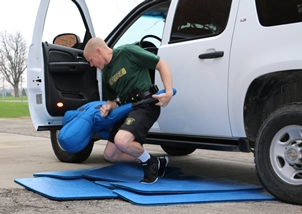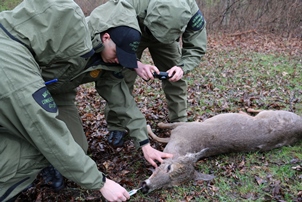Crime scenes, evidence kits and tactical training
Week 16: April 17-23
All seventeen recruits reported back to the Michigan Department of Natural Resources conservation officer academy Sunday, April 17, to begin week 16 of training. Throughout the week, they would focus on evidence collection and the final 16 hours of survival tactics training.
Start of evidence collection
Recruits began Monday morning with a five-mile run. Afterwards, they moved into the classroom for the beginning of evidence collection instruction taught by David Stephens, professor at Michigan State University’s School of Criminal Justice and an internationally recognized expert in wildlife forensics. DNR wildlife resource protection unit detectives also assisted throughout the week.
“Most law enforcement agencies, including the DNR Law Enforcement Division, have specialized individuals for evidence collection and investigations,” said Sgt. Jason Wicklund, recruit school commander. “Conservation officers handle the majority of their own evidence collection. Our officers are trained to be proficient in all aspects of this process.”
Throughout the morning, recruits were introduced to crime scene search, documentation, photography, and footwear and tire track impression evidence.
Survival tactics training
In the afternoon, recruits moved to the gym for survival tactics training, which took place every afternoon through Thursday. Survival tactics is a Michigan Commission on Law Enforcement Standards (MCOLES)-required program, which all law enforcement officers in the state must successfully complete, including DNR conservation officers, who are fully commissioned peace officers. MCOLES requires 79 hours of survival tactics training. Upon graduation, the recruits will have exceeded that minimum number.
 Using past training Using past training
Monday survival tactics training included a domestic assault scenario that employed skills, tactics and training the recruits had learned during the previous 15 weeks of the academy. During the scenario, which took place in the gymnasium of the Michigan State Police training facility, recruits individually responded as backup to a domestic assault taking place at a simulated county fairground. When recruits arrived, they attempted to use verbal skills to make an arrest. However, the suspect – played by a conservation officer – ignored commands and became physically aggressive toward the recruits who then utilized a Taser to subdue and arrest the suspect.
“During the scenario, recruits were expected to recognize active resistance and the aggression of a combative subject," Sgt. Wicklund said. "They needed to employ appropriate use of force when responding to the situation.”
Laboratory exercises
Recruits were back in the classroom Tuesday morning for more evidence collection instruction. They concentrated on laboratory exercises, including biological evidence (such as bloodstain pattern analysis), the DNR wildlife laboratory capabilities and collecting, packaging and transporting evidence.
Survival tactics evaluations
 After lunch, recruits reported to the gymnasium for the MCOLES and DNR survival tactics testing and evaluation. Recruits moved through 12 stations, encompassing various skillsets learned throughout the survival tactics program. Each recruit moved from station to station – from handcuffing and searching to ground assaults to weapon disarming - where they demonstrated every aspect of the survival tactics program. After lunch, recruits reported to the gymnasium for the MCOLES and DNR survival tactics testing and evaluation. Recruits moved through 12 stations, encompassing various skillsets learned throughout the survival tactics program. Each recruit moved from station to station – from handcuffing and searching to ground assaults to weapon disarming - where they demonstrated every aspect of the survival tactics program.
“The recruits must prove that they can handle themselves in any situation,” said Sgt. Wicklund. “These evaluations are proof positive that they can and will do so in the future should the need arise.”
View a short video of one component of survival tactics training.
Issued evidence kits
Wednesday, the trainees were issued evidence kits and taught how each item is used. Items in the kits consist of cameras, digital thermometers and digital scales, among many other pieces.
 During the training, recruits learned how to use digital cameras to document evidence. During the training, recruits learned how to use digital cameras to document evidence.
”Cameras are an important tool in law enforcement,” Sgt. Wicklund said. “Conservation officers must be able to document crime scenes, traffic accidents, injuries and any other type of evidence associated with a criminal investigation, and they must do this in a thorough and precise manner.”
More evaluations
Wednesday afternoon, recruits were back in the gymnasium finishing up final survival tactics testing and evaluations. This included vehicle extractions and the use of intermediate weapons such as batons and restraints.
Evidence kits and crime scenes
Recruits began to use their new evidence kits Thursday morning. They headed outside for two mock crime scenes. The first involved a harvested deer hanging from a pole. A kill tag was attached to the deer but may have been purchased after the deer had been killed. If it was, then the deer was poached. This is something the recruits, once they become conservation officers, will likely see at camps and homes. The recruits used their evidence kits to determine the deer’s time of death.
 “This is an important lesson for the recruits,” Sgt. Wicklund said. “This in-depth training will allow them to confidently use skills learned to determine if a deer was killed on the date and time given by a hunter.” “This is an important lesson for the recruits,” Sgt. Wicklund said. “This in-depth training will allow them to confidently use skills learned to determine if a deer was killed on the date and time given by a hunter.”
The second staged crime scene involved a gut pile from a deer – a heap of organs left after cleaning a deer. Once the recruits begin their careers, they will likely come upon this matter left in the woods. By using their kits, the recruits learned how to determine the gender of the deer and the time of death.
“Once again, this is an important skill that will be used throughout their careers,” Sgt. Wicklund said.
Taser training continued
Recruits were back inside during the afternoon for more survival tactics training. This included additional Taser training. Recruits were first introduced to this training during week nine of the academy when they ran through a Taser scenario. They fired three cartridges from their Tasers, one at close range during a quick deployment and two at targets in succession using a self-loading cartridge holster.
The recruits finished Thursday evening taking the written survival tactics test. This included all use of force and critical incident policies and procedures.
Mock crime scene
Friday, recruits participated in a mock crime scene involving a hunter fatality. As a group, they collected, processed and photographed evidence, including tire and footwear impressions in order to determine what had happened and why it had happened.
The recruits were dismissed Friday afternoon for the weekend. When they return Monday for the beginning of week 17, they will be completely engaged in first aid training.
Subscribe to the weekly conservation officer academy blog, which also is posted weekly on the Michigan DNR Facebook page. View past blogs from Recruit School No. 7.
# # #
/Photo details: Accompanying photos are available below for download. Caption information follows.
Arrest scenario.jpg: The arrest scenario challenged the recruits to recognize and respond to active resistance.
Survival tactics testing.jpg: During two days of survival tactics testing and evaluations, recruits rotated between 12 stations, one of which was ground assaults.
Vehicle extraction training.jpg: One of the 12 stations of survival tactics testing and evaluations included vehicle extractions.
Time of death determinor.jpg: Recruits use their evidence kits to determine a deer’s time of death during a crime scene scenario. (The deer used in the scenario was found dead alongside the road days prior, resulting from a deer-vehicle collision. After being tested at the DNR laboratory for disease, it was transported to the academy for use in the scenario.)
Physical combat training.jpg: Physical combat training is a component of survival tactics training, which the recruits engaged in during the week./
The Michigan Department of Natural Resources is committed to the conservation, protection, management, use and enjoyment of the state’s natural and cultural resources for current and future generations. For more information, go to www.michigan.gov/dnr.
|

 Using past training
Using past training
 During the training, recruits learned how to use digital cameras to document evidence.
During the training, recruits learned how to use digital cameras to document evidence. “This is an important lesson for the recruits,” Sgt. Wicklund said. “This in-depth training will allow them to confidently use skills learned to determine if a deer was killed on the date and time given by a hunter.”
“This is an important lesson for the recruits,” Sgt. Wicklund said. “This in-depth training will allow them to confidently use skills learned to determine if a deer was killed on the date and time given by a hunter.”




